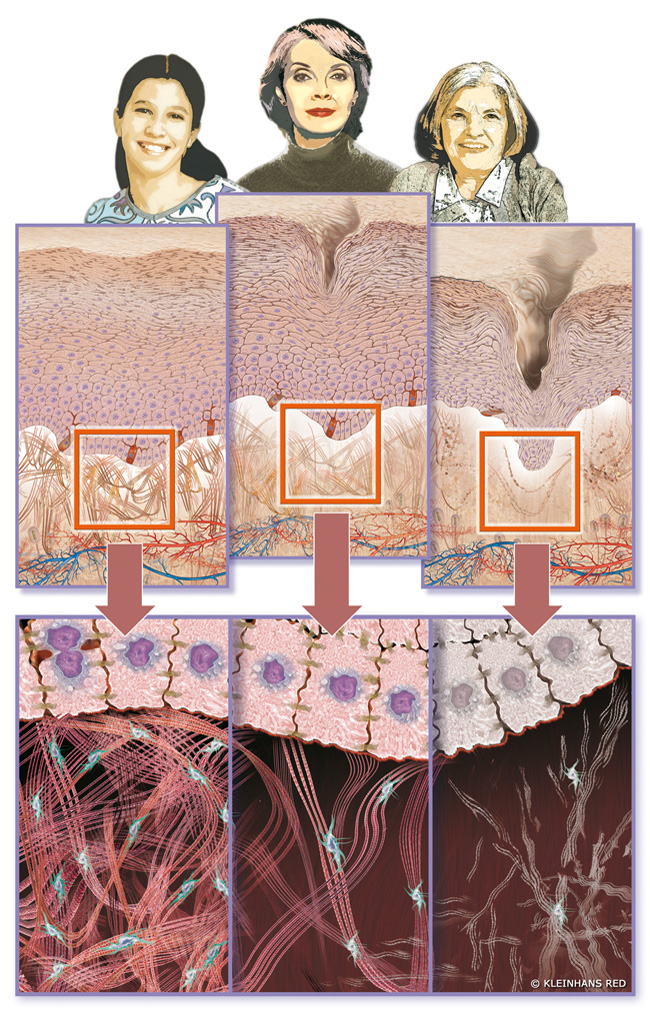Aging of the human skin

The formation of lines and wrinkles in light-exposed areas throughout the body, such as on the face, throat, décolleté and hands is a well-known sign of skin aging. Lines and wrinkles are influenced by both intrinsic and extrinsic factors. The numerous intrinsic factors are age, gender, genetic disposition and race. In exposed and unprotected zones of the body such as on the skin of the hands and the face, extrinsic factors such as UV light, weather and climatic influences, nutrition, tobacco and alcohol abuse, effect the formation of lines and wrinkles.
With increasing age, the physiology and appearance of the human skin will change. Alterations in structure, loss in tightness, smoothness and a decrease in the skin's functional capacity are phenomena which may be attributed to the aging mechanism. An increase in dryness and thus roughness as well as a loss in elasticity and even pigmentation are also a sign of increasing skin aging. Wrinkles on flaccid skin develop with growing age. There is a decline in the subcutaneous fatty tissue. Today, relatively little is known about the exact biochemical processes of skin aging. Mature skin is characterized by a decreasing barrier function, slower metabolic activities in all cells, a strong loss in humidity as well as a decrease in activity of the sebaceous and sweat glands.
Primarily, changes in the skin's appearance are a result of a general aging process of the connective tissue of the subcutis. This leads to an atrophy of the epidermis which adjoins the papillary layer and to an irregular decrease in the elasticity of the elastic nets which are structures accompanying the collagen fibres in the connective tissue. As a result of the changed amount and chemical composition of the basic substance of the connective tissue, a loss of liquids is the result, which consequently leads to a decrease in glycosaminoglycans, the basic structures of the connective and supporting tissues. As a consequence, the youthful turgor, i.e. the skin's tension, is lost. Melanocytes disintegrate or lose close contact to epidermal cells and finally lead to a spotted pigmentation of the skin.
Our illustration shows a schematic cross-section through the layers of the skin. The epidermis, also known as corium or horny layer and dermis are represented here. In the stratum corneum, the outer visible part of the epidermis, horny cells and horny substances are baked together and form plates. These plates are sloughed off as horny flakes.
In the enlarged area of our illustration the dense network of collagen fibres is represented. This is a typical feature of the dermis. This fibre net is made up of collagen, a protein and main component of intercellular supporting substances, provides the skin with tensile strength and a reversible formability. The dermis which holds blood and lymph vessels, the nervous network, connective tissue cells and cells of defense, is rich in glycosaminoglycans which are in charge of retaining water in the cells. Bundles of collagen fibres which are responsible for the building of tension within the connective tissue and show a disorderly alignment.
Younger skin shows a more complex network, a crossed and spiraled order of collagen fibres which - as aging progresses constantly loses its density, firmness and regular alignment.
Both epidermis which is located over the dermis, and the basal membrane which connects these two skin layers, are effected by aging mechanisms. In the dermis, changes in the composition of matrix proteins are primarily to be attributed to a loss in the skin's firmness and elasticity.
The aging process of the skin is a complex mechanism which is of particular interest for the cosmetic industry. Wrinkles and fine lines, especially on facial skin, are also a major topic in dermocosmetics. Effective products which may slow or delay skin aging or which prevent premature aging thus should have an effect on all relevant skin layers. Skin damage which is caused by sunlight may be counteracted by a number of antioxidants which fight free radicals and have a protective effect on the skin. The use of moisture-retaining substances is highly recommended in the treatment and care of aged skin.
Source: H. Leonhardt, Histologie, Zytologie und Mikroanatomie des Menschen, Volume 3, 8th Edition, Thieme 1990.
